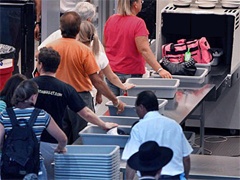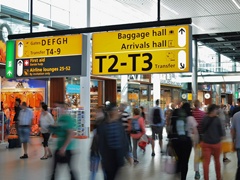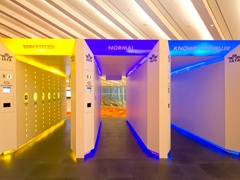 Airline passengers arrive at the airport. They check their bags, get their boarding passes, and head towards the security checkpoint. At the sight of long lines, some travelers gripe. Others have grown accustom to the long lines and see it as a regular part of the airport routine to keep civil aviation secure.
Airline passengers arrive at the airport. They check their bags, get their boarding passes, and head towards the security checkpoint. At the sight of long lines, some travelers gripe. Others have grown accustom to the long lines and see it as a regular part of the airport routine to keep civil aviation secure.
Industry discussions about the future of aviation security checkpoints seek to improve the screening process. Using risk-based security principles, the goal is to offer the same level of security, but with less invasive screening processes and more connected technology systems to make the traveler experience easier.
What is Risk-Based Security?
 The risk-based security approach is intelligence-driven and aims to move away from a traditional, one-size fits all screening model. It is based on the idea that a vast majority of travelers pose no risk to civil aviation. Therefore, not everyone should be screened the same way.
The risk-based security approach is intelligence-driven and aims to move away from a traditional, one-size fits all screening model. It is based on the idea that a vast majority of travelers pose no risk to civil aviation. Therefore, not everyone should be screened the same way.
Part of this approach is to establish a voluntary, pre-screening process for passengers who wish to qualify for expedited screening at the airport. The other part is to establish more integrated checkpoint screening suites that are less invasive than current screening methods used today.
What are the Benefits of Risk-Based Security?
It expedites the screening process and increases passenger throughput at the airport which results in more satisfied travelers and airport workers. Theoretically, it allows security screeners to focus more attention on those who should be subjected to further screening. It may also allow for a reduction in the screener workforce because of operational efficiencies which turns into financial savings.
Why is it Imperfect?
The risk-based security approach fails to take into consideration the lone wolf - when a no risk passenger unexpectedly becomes high risk to aviation. Just because a passenger flies thousands of miles per year, joins all of the frequent flyer programs, and qualifies for expedited screening, does not mean he/she will not pose a risk to aviation.
The risk-based approach does, in fact, sacrifice some level of security in exchange for speed and throughput. Is the increase in throughput worth the risk of an aviation disaster?
What Does This Mean for the Screening Process?
 A less invasive screening process means more items are left in luggage and on passengers. This makes screening more difficult and demanding for security screeners. Screeners must work harder and be extremely proficient to detect threats. Screener training will continue to remain an important component of on-the-job readiness as the future of security checkpoint becomes a reality for the industry.
A less invasive screening process means more items are left in luggage and on passengers. This makes screening more difficult and demanding for security screeners. Screeners must work harder and be extremely proficient to detect threats. Screener training will continue to remain an important component of on-the-job readiness as the future of security checkpoint becomes a reality for the industry.
Summary
The future of aviation security checkpoints hold a lot of potential. It will be interesting to see how equipment manufacturers can bring integrated screening technology systems to life, how the industry will overcome the imperfections of risk-based security, and how airports will implement the screening process.
In the meantime, airports need to make sure to develop and maintain a stringent training program for all screening methods used, build in processes and procedures that require ongoing training exercises, and share information about successful detections with others in the industry to create a learning environment.
What are your thoughts about the future of aviation security checkpoints via risk-based security? Let us know below.
